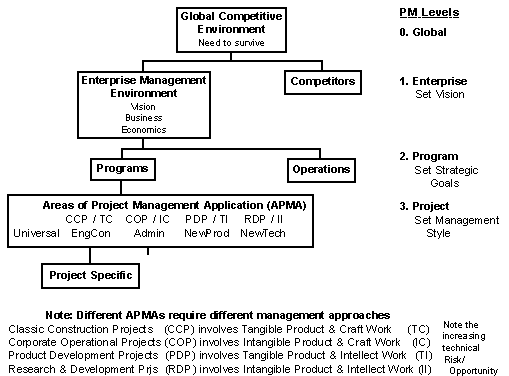Continued Development since 1998
Since the presentation of this paper in 1998 work on the PMKS has continued.
For example, if we take the upper part of the structure shown in Exhibit
4 we might label the levels progressively from the top as Enterprise; Program;
and Project as shown in Exhibit 5. Note that the program
level corresponds to the strategic focus of the organization, which determines
the type of project according to different Areas of Project Management Application
(APMAs). The APMAs reflect the 'nature' of the project environment and all that
this entails (Shenhar 1997).
Exhibit 5 highlights the differences between the four
major APMAs which determine the appropriate style of management for the project
to be successful in implementation. The APMA box also shows the given name used
in Wideman's Issues and Considerations as a broad characterization of each application
area. The label 'Universal' provides the opportunity to categorize project management
knowledge, as distinct from program management knowledge, that appears to be
universal across all four APMAs.

Exhibit 5. Labeling the Project Environment
Next, if we take the lower part of Exhibit 4,
we can add appropriate labels from the project on down as shown in Exhibit
6. Note that the seven subdivisions of the project-specific knowledge areas
are identified as Components at level 4 and that each of these have attributes
as suggested at the Process level 5. Note also that the attributes or subject
matter shown in bold are those representing the knowledge areas contained in
the Project Management Institute's Guide to the Project Management Body of Knowledge.
We have suggested that much project management knowledge becomes customized
at the project application level. While most of the methodology, or processes
at the function level, or tools and techniques at the component level have universal
application, nevertheless, their practical application need to be 'interpreted'
for each APMA by virtue of:
- The types of people, culture, attitudes and vocabulary involved
- The types of scope, quality, time frames and cost ranges encountered, and
- The types of information, communication, teamwork, skills and work effort
required.
Exhibit 6. Labeling the Project Content
|



